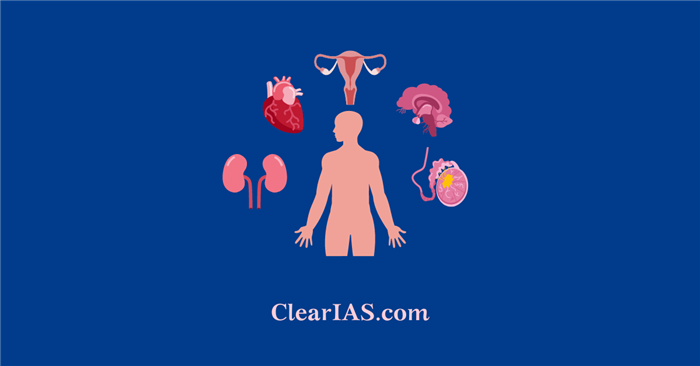Endocrine Glands and Hormones

What are Hormones? What are the different endocrine glands? Read further.
Endocrine glands are organs that produce hormones and release them directly into the bloodstream to regulate various bodily functions.
Hormones are chemical messengers that are responsible for controlling and coordinating many different physiological processes, such as growth and development, metabolism, reproduction, and stress response.
This article will list endocrine glands, and hormones released by them and their function in our body.
Endocrine Glands and Hormones in Human Body
There are several endocrine glands in the human body, including:
Pituitary Gland
The pituitary gland, also known as the hypophysis, is a small, pea-sized gland located at the base of the brain. It is often called as the “master gland” because it produces and secretes a variety of hormones that regulate the function of many other endocrine glands in the body.
The pituitary gland is divided into two main parts: the anterior pituitary (adenohypophysis) and the posterior pituitary (neurohypophysis). The anterior pituitary is composed of glandular tissue and secretes several hormones, while the posterior pituitary is made up of nerve tissue and stores and releases two hormones produced by the hypothalamus.

Hormones Produced by the Anterior Pituitary:
- Growth Hormone (GH): Stimulates growth and cell reproduction in bones, muscles, and other organs.
- Thyroid-Stimulating Hormone (TSH): Stimulates the thyroid gland to produce thyroid hormones that regulate metabolism.
- Adrenocorticotropic Hormone (ACTH): Stimulates the adrenal glands to produce cortisol, a hormone that helps the body respond to stress.
- Follicle-Stimulating Hormone (FSH) and Luteinizing Hormone (LH): Regulate the menstrual cycle and reproductive function in females and stimulate the production of testosterone in males.
- Prolactin: Stimulates milk production in females after childbirth.
- Melanocyte-Stimulating Hormone (MSH): Stimulates the production of melanin, a pigment that gives color to the skin, hair, and eyes.
Hormones Produced by the Posterior Pituitary:
- Antidiuretic Hormone (ADH): Regulates water balance by decreasing the amount of water excreted in the urine.
- Oxytocin: Stimulates uterine contractions during childbirth and promotes the release of milk from the breasts during nursing.
Thyroid Gland
The thyroid gland is a butterfly-shaped endocrine gland located in the neck, just below Adam’s apple. It produces and secretes several hormones that are essential for maintaining normal bodily functions.
The thyroid gland is composed of two lobes that are connected by a small band of tissue called the isthmus. It is situated in front of the trachea and just below the larynx. The thyroid gland is made up of follicular cells, which produce and secrete the hormones T3 and T4, and parafollicular cells, which produce the hormone calcitonin.
Hormones Produced by the Thyroid Gland:
- Thyroxine (T4): The thyroid gland produces about 80% of T4, which is converted to T3 in various organs and tissues. T4 and T3 are responsible for regulating metabolism, growth, and development in the body.
- Triiodothyronine (T3): T3 is the more active form of thyroid hormone and is responsible for regulating metabolic processes such as energy production, heart rate, and body temperature.
- Calcitonin: Calcitonin helps regulate calcium levels in the body by reducing the amount of calcium released from bones.
Adrenal Gland
The adrenal gland is an endocrine gland located above each kidney. It plays a critical role in the body’s response to stress and the regulation of various bodily functions.
The adrenal gland is divided into two main regions: the outer adrenal cortex and the inner adrenal medulla. The adrenal cortex produces hormones that are essential for life, while the adrenal medulla produces hormones that help the body respond to stress.
Hormones Produced by the Adrenal Cortex:
- Cortisol: Cortisol is the primary hormone produced by the adrenal cortex and plays a vital role in regulating metabolism, immune response, and the body’s response to stress.
- Aldosterone: Aldosterone is a hormone that helps regulate salt and water balance in the body by increasing the reabsorption of sodium ions and the excretion of potassium ions.
- Androgens: The adrenal cortex also produces androgens, which are male sex hormones that are also present in females. Androgens play a role in the development of male sexual characteristics and contribute to the sex drive in both men and women.
Hormones Produced by the Adrenal Medulla:
- Epinephrine (adrenaline): Epinephrine is a hormone that is released in response to stress and helps prepare the body for the “fight or flight” response. It increases heart rate, dilates blood vessels, and causes the air passages in the lungs to widen, allowing more oxygen to enter the body.
- Norepinephrine (noradrenaline): Norepinephrine is another hormone that is released in response to stress and works with epinephrine to prepare the body for the “fight or flight” response.
Pancreas
The pancreas is a vital organ located in the abdomen, behind the stomach. It plays an essential role in both the digestive and endocrine systems of the body.

The pancreas is a glandular organ that is approximately 6 to 10 inches long and shaped like a thin, flat tadpole. The pancreas is divided into two main sections: the exocrine pancreas and the endocrine pancreas.
Hormones Produced by the Endocrine Pancreas:
- Insulin: Insulin is a hormone that regulates the body’s blood sugar levels. It is produced by beta cells in the islets of Langerhans and helps to lower blood sugar by promoting the uptake and use of glucose by cells throughout the body.
- Glucagon: Glucagon is a hormone that works in opposition to insulin, raising blood sugar levels. It is produced by alpha cells in the islets of Langerhans and promotes the breakdown of glycogen (stored glucose) in the liver, releasing glucose into the bloodstream.
- Somatostatin: Somatostatin is a hormone that inhibits the release of both insulin and glucagon, helping to regulate blood sugar levels.
Gonads
The gonads are a pair of endocrine glands responsible for the production of sex hormones and gametes (reproductive cells) in both males and females. In males, the gonads are the testes, while in females, the gonads are the ovaries.
The testes and ovaries are both responsible for producing sex hormones and gametes, but they have different structures and functions. The testes are located in the scrotum, and they are responsible for the production of testosterone, which is the primary male sex hormone. Testosterone is responsible for the development of male reproductive organs, secondary sexual characteristics, and the regulation of sperm production.
The ovaries are located in the pelvis, and they are responsible for the production of estrogen and progesterone, which are the primary female sex hormones. Estrogen is responsible for the development of female reproductive organs, secondary sexual characteristics, and the regulation of the menstrual cycle. Progesterone is involved in the regulation of the menstrual cycle and plays a crucial role in pregnancy.
Hormones Produced by the Gonads:
- Testosterone: Testosterone is produced by the Leydig cells in the testes and is responsible for the development of male reproductive organs, secondary sexual characteristics, and the regulation of sperm production.
- Estrogen: Estrogen is produced by the follicles in the ovaries and is responsible for the development of female reproductive organs, secondary sexual characteristics, and the regulation of the menstrual cycle.
- Progesterone: Progesterone is produced by the corpus luteum in the ovaries and is involved in the regulation of the menstrual cycle and plays a crucial role in pregnancy.
Thymus gland
The thymus gland is a small, bi-lobed organ located behind the sternum and in front of the heart. It is part of the endocrine system and plays a critical role in the development of the immune system.

The thymus gland is a unique organ because it is active primarily during childhood and adolescence, gradually becoming smaller and less active as we age.
Hormones Produced by the Thymus:
- Thymosin: Thymosin is a hormone that is involved in the maturation of T-cells. It is produced by the epithelial cells in the thymus and helps to stimulate the development and differentiation of T-cells.
- Thymulin: Thymulin is a hormone that is involved in the regulation of the immune system. It is produced by the epithelial cells in the thymus and helps to stimulate the production of T-cells and the function of certain immune cells.
Heart
The heart is primarily known for its role in pumping blood throughout the body, but it also has an endocrine function.
The heart is a muscular organ that is located in the chest cavity. It is composed of four chambers: the right and left atria and the right and left ventricles. The heart’s primary function is to pump blood throughout the body, but it also plays a role in the endocrine system.
Hormones Produced by the Heart:
- Atrial natriuretic peptide (ANP): ANP is a hormone that is produced by the cells in the atria of the heart. It helps to regulate blood pressure and blood volume by promoting the excretion of sodium and water by the kidneys.
- Brain natriuretic peptide (BNP): BNP is a hormone that is produced by the cells in the ventricles of the heart. It also helps to regulate blood pressure and blood volume by promoting the excretion of sodium and water by the kidneys.
- C-type natriuretic peptide (CNP): CNP is a hormone that is produced by the cells in the endothelium of the heart. It helps to regulate blood pressure by promoting vasodilation, which widens blood vessels and increases blood flow.
Gastrointestinal tract
The gastrointestinal tract (GI tract), also known as the digestive system, is responsible for the digestion and absorption of food. It is also an important endocrine gland that produces several hormones involved in the regulation of various bodily processes.
It is composed of several organs, including the mouth, esophagus, stomach, small intestine, large intestine, rectum, and anus. The primary function of the GI tract is to break down food into nutrients that can be absorbed into the body.
Hormones Produced by the GI Tract:
- Gastrin: Gastrin is produced by the cells in the stomach lining. It stimulates the production of hydrochloric acid in the stomach, which helps to break down food.
- Secretin: Secretin is produced by the cells in the duodenum (the first part of the small intestine). It stimulates the pancreas to produce bicarbonate, which neutralizes the acid in the stomach and helps to protect the small intestine from damage.
- Cholecystokinin (CCK): CCK is produced by the cells in the duodenum. It stimulates the pancreas to produce enzymes that help to break down fats, proteins, and carbohydrates in food. It also stimulates the gallbladder to release bile, which helps to digest fats.
- Glucagon-like peptide-1 (GLP-1): GLP-1 is produced by the cells in the small intestine. It stimulates the pancreas to produce insulin and inhibits the production of glucagon, which helps to regulate blood sugar levels.
Kidneys
The kidneys are complex organs responsible for filtering blood and removing waste products from the body. In addition to their well-known role in excretion and regulation of fluid and electrolyte balance, the kidneys also function as an endocrine gland.
Hormones Produced by the Kidneys:
- Erythropoietin (EPO): EPO is produced by cells in the kidneys and stimulates the production of red blood cells in the bone marrow. It is essential for maintaining adequate levels of oxygen in the body.
- Renin: Renin is produced by cells in the kidneys and is involved in regulating blood pressure. It works by converting angiotensinogen, a protein produced by the liver, into angiotensin I, which is then converted into angiotensin II. Angiotensin II causes blood vessels to constrict, which raises blood pressure.
- Calcitriol: Calcitriol, also known as vitamin D3, is produced by cells in the kidneys and is involved in regulating calcium levels in the body. It stimulates the absorption of calcium from the intestines and helps to maintain healthy bones.
Pineal gland
The pineal gland is a small, pinecone-shaped endocrine gland located in the brain. It produces the hormone melatonin, which plays a crucial role in regulating the body’s sleep-wake cycle.
The pineal gland is located in the center of the brain, between the two hemispheres. It is made up of pinealocytes, which are specialized cells that produce and secrete melatonin. The pineal gland is controlled by the suprachiasmatic nucleus (SCN) of the hypothalamus, which receives information from the eyes about light and darkness and helps to regulate the body’s circadian rhythms.
Hormone Produced by the Pineal Gland:
The pineal gland produces the hormone melatonin, which is involved in regulating the body’s sleep-wake cycle. Melatonin is produced in response to darkness and is inhibited by light. It is released into the bloodstream and helps to promote sleepiness and regulate the timing of sleep.

Parathyroid gland
The parathyroid gland is a small endocrine gland located in the neck, near the thyroid gland. It produces a hormone called parathyroid hormone (PTH), which plays a crucial role in regulating the body’s calcium levels.
Hormone Produced by the Parathyroid Gland:
The parathyroid gland produces a parathyroid hormone (PTH), which plays a critical role in maintaining the body’s calcium balance. PTH is released in response to low levels of calcium in the blood, and it works to increase the levels of calcium by stimulating the release of calcium from bones, increasing the absorption of calcium in the intestines, and reducing the excretion of calcium in the kidneys.
Conclusion
In conclusion, the endocrine system is a complex network of glands and hormones that regulate numerous physiological processes in the body. The proper functioning of the endocrine system is essential for maintaining homeostasis, growth, development, and reproduction. Hormones play a critical role in this system by acting as chemical messengers that communicate with cells throughout the body.
Article Written By: Priti Raj